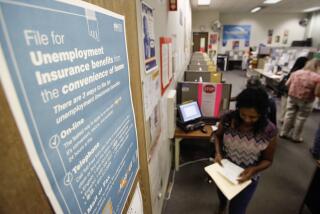The Evolving Workplace
- Share via
The workplace--influenced by an explosion of technology, a changing work force and global markets--has changed more in the past century than ever before. And it continues to change.
Nationally, economists are predicting a surge in jobs catering to aging baby boomers, including everything from retirement planner to nursing-home activities director. Advancements in medical and computer technology will create many jobs.
On the day before Labor Day, here’s a look at some of the trends affecting the workplace of the future.
What Will Tomorrow Bring?
No one knows exactly what the future will mean to the workplace, but here are a few predictions from the experts:
* An aging population and the advancement of medical technology will make health-care services one of the fastest-growing industries nationwide in the 21st century.
* “Knowledge jobs” (those that require brainpower, not manual skills) will increase.
* The dearth of workers with up-to-date job skills will continue, especially in Southern California.
* Employers will find ways to hire and retain aging baby boomers, especially those having up-to-date skills.
* The number of minority employees will increase from 23% in 1994 to 26% in 2005.
* Female workers will increase slightly, from 46% in 1994 to 48% in 2005.
Sampling of Hot Careers for the 21st Century (plus estimated salary range):
Physician ($75,000 to $250,000)
Geriatric social worker ($24,000 to $48,000)
Systems analyst ($25,000 to $70,000)
Environmental engineer ($30,000 to $85,000)
Copywriter ($18,000 to $85,000)
Accountant ($25,000 to $100,000)
Aerobics instructor ($12,000 to $35,000)
Teacher (elementary and secondary) ($26,000 to $55,000)
Hotel/motel manager ($25,000 to $90,000)
Meteorologist ($19,000 to $100,000)
From “100 Best Careers for the 21st Century” by Shelly Field
Sampling of Futuristic Jobs:
Asteroid/lunar miner
Robot trainer
Laser-medicine practitioner
Bionic-medicine technician
Thanotologist (studies the terminally ill)
Underwater archeologist
Pollution botanist
Selenologist (studies the moon as a geologist studies the earth)
Planetary engineer
From “The 100 Best Jobs for the 1990s and Beyond” by Carol Kleiman (collected by Washington consultant Norman Feingold)
10 Fastest-Growing Occupations, 1994-2005 (nationwide)
Occupation Employment: 1994/2005 Percent change
Personal and home-care aide: 118%
Home health aide: 102%
Systems analyst: 92%
Computer engineer: 90%
Database administrator, computer-support specialist: 89%
Physical therapist: 80%
Residential counselor: 76%
Human-services worker: 75%
Medical assistant: 59%
Paralegal: 58%
As projected by the Bureau of Labor Statistics
10 Fastest-Growing Occupations, 1993-2005 (Los Angeles County)
Occupation Employment: 1993/2005 Percent change
Athlete, coach, umpire: 168%
Home health-care worker: 155%
Computer engineer: 131%
Film editor: 131%
Personal and home-care aide: 124%
Human-service worker: 119%
Curator, archivist: 117%
Computer scientist: 117%
Producer, director, actor: 98%
Tax preparer: 94%
As projected by the Employment Development Department of California and the Bureau of Labor Statistics
Sources: Hudson’s Workforce 2020 study, U.S. Department of Labor, Bureau of Labor Statistics, staff reports.
10 Fastest-Shrinking Occupations, 1994-2005 (nationwide)
Occupation Employment: 1994/2005 Percent change
Computer operator: -37%
Typist and word processor: -33%
Machine-tool operator: -29%
Bank teller: -27%
Sewing-machine operator: -26%
Duplicating, mail and other office-machine operators: -25%
Textile worker: -25%
Cleaner/servant, household: -22%
Farmer: -21%
Personnel clerk, except payroll and timekeeping: -21%
As projected by the Bureau of Labor Statistics
Researched by STEPHANIE STASSEL / Los Angeles Times
More to Read
Inside the business of entertainment
The Wide Shot brings you news, analysis and insights on everything from streaming wars to production — and what it all means for the future.
You may occasionally receive promotional content from the Los Angeles Times.










